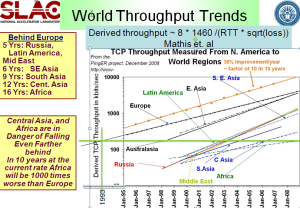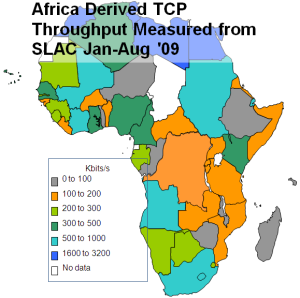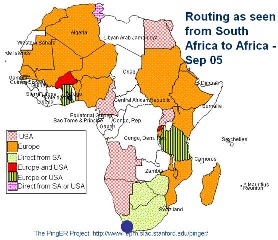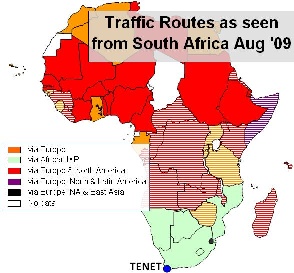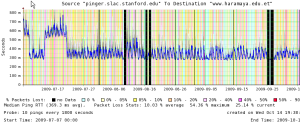...
<ac:structured-macro ac:name="unmigrated-wiki-markup" ac:schema-version="1" ac:macro-id="1277f2c37dc02508-db84fcec-49ce435f-9c7895b1-1d3252ac17343079b43408a8"><ac:plain-text-body><![CDATA[ | Throughput from SLAC to Regions of the World | Derived Throughput from SLAC to Africa Jan-Aug '09 [[xlsx | ^africa-thru-aug09.xlsx]] | MinRTT from SLAC - Aug. 2009 [[xls | ^map-africa-minrtt-aug2009.xls]] | ]]></ac:plain-text-body></ac:structured-macro> |
|---|---|---|---|---|---|---|
|
|
|
...
<ac:structured-macro ac:name="unmigrated-wiki-markup" ac:schema-version="1" ac:macro-id="52a3ae34ac23b81a-494fc930-49e4461e-bea1ba69-c21765a0da934fc0b5c46a56"><ac:plain-text-body><![CDATA[ | Routing from South Africa to African Countries (Sep '05) | Routing from South Africa to African Countries (Aug '09) [[xls | ^routing-africa-aug2009.xls]] | Routing from Burkina Faso to African Countries (Aug '09) [[xls | ^routing-africa-aug2009.xls]] | ]]></ac:plain-text-body></ac:structured-macro> |
|---|---|---|---|---|---|---|
| |
|
...
- for www.ku.ac.ke from ICTP the change is from 800ms to ~200ms (a factor of ~4 improvement) while from SLAC it is 650ms to ~350ms (or less than a factor of 2improvement2 improvement)
- for mail2.starcom.co.ug from ICTP the change is from ~ 600ms to 200ms (or a factor of 3 times) while from SLAC it is 800ms to 350ms (or just over a factor of 2 improvement)
...
One host (www.aisha.ac.zm) of the 6 monitored in Zambia improved its RTT from about 720ms to 550ms on August 20, 2009 (see below). Also at the time of writing it looks like they are still THey then spent many days moving the link over to the terrestrial lines since . During this time the performance is was very unstable (high losses) and there are were big changes in RTT. It is possible probable the link in one direction is was using a GEOS while the other is was an all terrestrial link and the large dips to 400ms are were when both legs are were using terrestrial links. We believe the terrestrial path goes via Botswana and Namibia. The traceroute from SLAC on 9/9/09 appeared to use a satellite link in at least one direction. On October 2THe final cutover to terrestrial linkis in both directions appears to have been made on October 23rd when the RTT drpped to ~350ms and the link appeared more stable. On October 2, 2009 Mike Jensen reported that the traceroute from Rome to www.aisha.ac.zm was well below 450ms and thus appears to be a terrestrial link. However the tracreoute from SLAC was still taking over 550ms. Also the traceroute from TENET/Cape Town South Africa to www.aisha.ac.zm took over 650ms. The traceroute from NUST, Islamabad, Pakistan to mail.unza.zm takes less than 450ms and appears to be a terrestrial path going via Namibia. On October 7th 2009 the traceroute from SLAC to mail.unza.zm appeared to be terrestrial and went via Namibia.
Angola: www.novagest.co.ao | Ethiopia: www.haramaya.edu.et | Namibia: www.adsl.com.na | ||
|---|---|---|---|---|
| |
| ||
Zambia: www.aisha.ac.zm |
|
| ||
|
|
|
Fractional Conversion
The table below shows the number of hosts monitored from SLAC in the country and the number of those that used a terrestrial path as of a particular date.
...
On September 6th, 2009 it was reported that the Glo-1 Submarine cable landed in Lagos, Nigeria. The 9800km cable is coming from Bude in the UK and connects Nigeria to the rest of West Africa and the UK. It has landing points in Nigeria, London and Lisbon in Portugal. It is deploying 16 branching units to connect countries in West Africa. It is a project jointly executed by Globacom and its partners, Alcatel Lucent. this brings competition to the SAT3/WASC/ cable consortium. In May 2010 the Main One cable will be landing on the West Coast of Africa.
Further Reading
The Cable Guy: How to Network a Continent is a great Wired UK article that tells a compelling story illustrating the physical dimension and the challenges of deploying broadband in Africa.
How to Cross the Digital Divide, Rwanda-Styleprovides an interesting case study of how Rwanda has been able to somewhat bridge the digital divide in a methodological manner.MANGO-NET (Made in Africa NGO NETwork)
